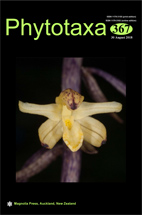Abstract
Cabomba schwartzii was described by Rataj in 1977. The species discovered in the Brazilian Amazon was said to differ from other Cabomba species in having two sepals, two petals and a lobate petal base. According to the 1991 study of Ørgaard, C. schwartzii is similar to C. aquatica in other morphological characters (C. aquatica has flowers with three sepals and three petals) and since variation in number of floral parts is common in the genus, Ørgaard synonymized both species. After an analysis of C. schwartzii type material, other herbarium collections and location of four populations (two with C. schwartzii characteristics and two with C. aquatica characteristics), we conducted an integrated morphological and genetic study to evaluate whether or not C. schwartzii is a distinct species from C. aquatica. The results reveal the species to be distinct from each other and therefore C. schwartzii should be reestablished. The floral formula for C. schwartzii is K2 C2 A2+2 G1, versus K3 C3 A3+3 G2 for C. aquatica. A detailed species description and the geographical distribution of C. schwartzii are presented with a dichotomous key to distinguish both species, together with illustrations.

